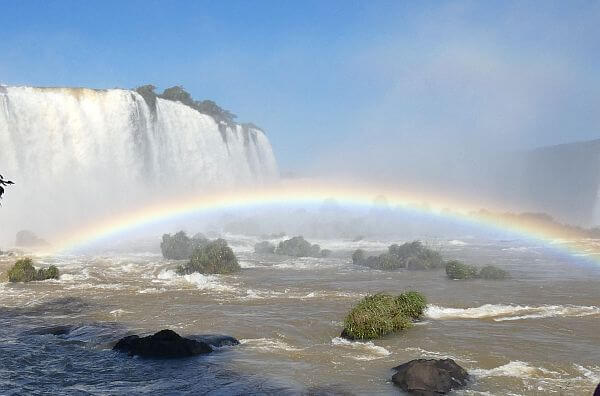Is Brazil on your bucket list? If so, you’d better get your tickets now and head there before January 10, 2024 if you’re from the USA, Canada, or Australia. Because after that, a big South America visa change is coming, the first one in many years. Brazil is going to start charging you a significant sum for the pleasure of spending your money there.

When the former president of Brazil saw the tourism numbers spike in Argentina and Chile after they dropped their reciprocal visa fee, he rightly assumed the same thing would happen in Brazil if they dropped their expensive entry visa. It was only in place for a year before the pandemic hit, however, so there was no time to really see an impact from this South America visa change, especially since Brazil’s Covid-19 deaths numbers were among the highest in the world per capita. Nobody wanted to visit Brazil at that time.
The New Visa Charge to Visit Brazil
The new president wanted to make his mark when entering office and took action to roll back this decision and return to the old ways. Citing fairness as the reason, travelers coming to Brazil on vacation will pay the same amount Brazilians pay to go the other direction. (Never mind that some Brazilians stay in the U.S. or Canada illegally but that seldom happens in reverse.) So now the Brazil visa fee will be a whopping $160 per person for Americans, or $640 shelled out before arriving for a family of four. “Family travel in Brazil” may become an oxymoron.
As best I can tell, the amount for Canadians will jump from zero to US$80 and for Australians, it is going to be US$45.
This was originally supposed to be switched over in October, but the government couldn’t get its act together in time and it was pushed back to January 10, 2024. If they are still not ready for you to get your travel visa online at that point, I assume they will delay it again.
You will not be able to just show up at the airport once this system is ready. You will need to apply in advance online with supporting documents and pay the hefty fee.
To play it safe, I would plan that trip to Rio de Janeiro, Iguacu Falls, or the beaches to arrive before January 10. After all, $160 will pay for a lot of meals or cocktails. And you’d be supporting local business owners with that money instead of handing it all over to the government.
Check flight prices from your airport here.

This is going to make it especially complicated and expensive to visit Iguazu Falls on the Argentina side and the Brazilian side. For the past few years that was easy since both countries were visa-free, but now it’s going to mean a very expensive crossover. So I imagine we’ll go back to the situation where Argentina is getting 3X the number of foreign visitors on their side that Brazil is getting on theirs.
If you’re wondering whether this is the most expensive South America visa, the answer is that it’s a tie. Bolivia also has the same reciprocal visa scheme, which is one reason why it gets far fewer visitors than its neighbors. Plus Bolivia has even fewer arrangements with other nations than Brazil does, so it’s more than just Americans, Canadians, and Australians who will pay to enter there.
Other Latin America Visa News
While the South America visa news is negative, I’ve got good news for two Latin American countries north of the Panama Canal.
Costa Rica announced in September that they are extending the time that visitors can stay in their country with a tourist visa obtained on arrival, from 90 days to 180 days. This applies to all “group one” countries that only need a passport to enter Costa Rica. There are a lot of countries on this list including the USA, Canada, most European countries, most South American countries, Japan, and South Africa.

This is especially great news for snowbirds who escape the cold up north and come down to Costa Rica for the winter. Previously, if they wanted to stay more than 90 days, they had to do a border run to a neighboring country and return with a new passport stamp. Now they can stay for nearly six months.
This is also great news for remote workers and nomads who want to explore Costa Rica in depth while still getting their work done when needed. And hey, that’s good for the planet too since Costa Rica gets most of its power from renewable energy. Last, it’s good news for those who want to invest in Costa Rica real estate and don’t want to rush the process.
The last change is a procedural rule that’s making it easier on visitors: Mexico’s “permission to stay” visa on arrival is now electronic instead of being in paper form, now at nearly every airport. Previously, visitors had to fill out a paper form upon arrival in Mexico and they then had to hang onto the bottom stub of that form the whole time they were in the country, surrendering it upon departure. Anyone who lost it had to pay a fine.
Now that the system is electronic and passport-based, there’s no paper to keep track of and this means there’s less chance an immigration officer in a bad mood will put less than the standard 180 days in your passport.
See where to stay when you get there with our extensive reviews of luxury Mexico hotels throughout the country.
Article by Timothy
Timothy Scott is the founder and editor of Luxury Latin America and has been covering the region as a travel journalist since the mid-2000s. He has visited each country we cover multiple times and is based in a UNESCO World Heritage city in central Mexico, where he owns a home. See contact information here.
